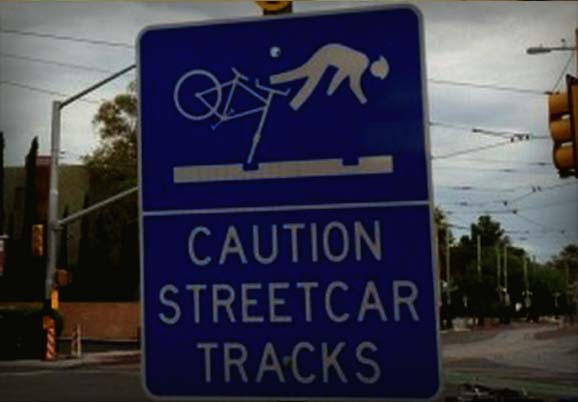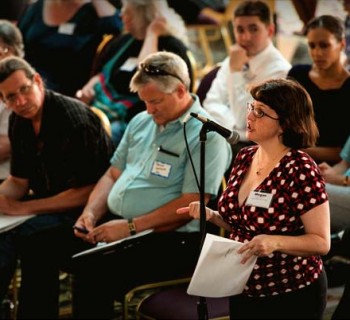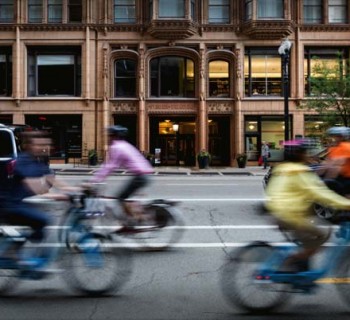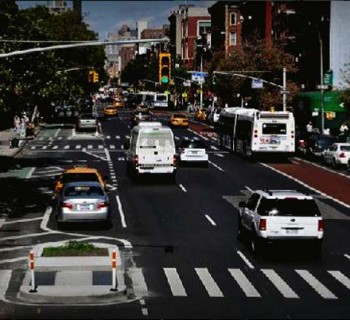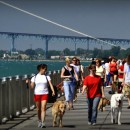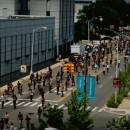DETROIT—M-1 Rail is inching closer to reality every day, with construction expected to begin on the streetcar system before the end of the year. However, while there’s lots of anticipation right now about getting the project rolling, there are also plenty of folks who aren’t quite on board with the endeavor.
The most vocal of these critics took to the streets of Detroit last week to participate in a seven-day march called the Jericho Journey, organized by the North End Woodward Community Coalition, a transportation justice group. Organizers say they weren’t trying to scuttle the M-1 Rail effort, but rather wanted to draw attention to different “challenges” the proposed 3.3 mile Woodward Avenue trolley poses to the community.
They also have some concrete goals as well; the organization is seeking a community benefits agreement with the M-1 Rail organization and has pushed for general changes in how the city handles development with respect to the community.
“At first we supported the M-1 light rail system. We believed light rail was a good thing and would connect people to job centers and thus be a blessing to the people who are transit dependent," Rev. Joan Ross, a spokeswoman for the coalition told Mode Shift. ”Light rail died, much to our despair, and what was born in its place is a streetcar.”
The NEWCC is concerned that local people won’t really benefit from this current arrangement, which Ross says is more of a “real estate product” than a “transit product.”
The coalition is particularly troubled by plans to put a maintenance station in Detroit’s North End neighborhood, which stretches across Woodward from I-94 to Highland Park. According to Ross, the station doesn’t have boarding and North End residents will have to walk all the way to the Amtrak Station at West Baltimore to ride the streetcar.
M-1 Rail spokesman James Canning disputed this in an e-mail to Mode Shift, noting that a station is planned for Grand Boulevard north of the Amtrak station. He added that the maintenance center will create employment opportunities in the neighborhood.
“It’s important to note that the M-1 RAIL project will also be utilizing Federal New Market Tax Credits in its financing structure,” he said. “The Federal provisions of the program are targeted to census tracts federally classified as ‘low income.'”
Last week’s march also highlighted potential adverse impacts the streetcar could have on various types of commuters.
Ross worries that the new system will push bus traffic off Woodward, complicating commutes for those who depend on buses to get around. She’s also concerned about how it will affect those with disabilities.
“One of the big concerns are the people who are physically challenged. It’s almost impossible for them to navigate the streets on Woodward Avenue as they are,” she said. “Trying to get from one side of Woodward to the other is impossible if you’re challenged, and once you put this rail in you’re making it more of a challenge.”
Canning responds that M-1 has been working with a wide range of public, private and regional transportation entities including DDOT, SMART, the People Mover, AARTA, Transit Windsor and the RTA to make the streetcars “easily accessible for the community.” He said accommodating disabled passengers will be a top priority.
“Plans are for all six of the streetcars to be ADA compliant, as well as the stations,” he said. “M-1 has been working with groups such as Warriors on Wheels and TRU to identify best practices for ADA compliance.”
Will M-1 Rail be bike-friendly?
Members of Detroit’s cycling community also participated in the Jericho March last week to raise awareness about bicycle safety near the tracks.
Current plans call for M-1 Rail’s streetcars to travel on track that is center-running from Grand Boulevard to Burroughs and side-running south of Burroughs to Larned.
Bicycling advocate Todd Scott of the Detroit Greenways Coalition and Michigan Trails and Greenways Alliance told Mode Shift the side-running segment could have dangerous consequences for cyclists.
“The main thing is when you’re riding parallel to the tracks … your wheels can get caught in the tracks,” he said. “The other issue as well is when you’re riding there, when a streetcar is riding behind you, you might be tempted to swerve into one of the vehicle lanes.”
Furthermore, Scott said the project doesn’t comply with Michigan’s Complete Streets law. Public Acts 134 and 135 of 2010 requires that "roadways planned, designed, and constructed to provide appropriate access to all legal users … whether by car, truck, transit, assistive device, foot or bicycle." This applies not just to MDOT projects, but private projects the agency allows on state roads, according to Scott.
M-1 maintains that project is “compatible with the State Transportation Commission Policy on Complete Streets” and that it is an active participant Woodward Avenue Complete Streets Master Plan.
In his e-mail to Mode Shift, Canning explained the reasons for the curb-running track and gave assurances that the organization would work to educate cyclists on potential safety issues.
“The design strikes a balance for all modes of transportation (motorized and non-motorized) and encourages investment along the corridor for the entire community," Canning said. "The vehicles are being designed so that cyclists can coexist with the streetcar. M-1 will participate in additional outreach within non-motorized groups to continue to discuss further steps that can be taken to ensure bike safety along and around the Woodward Corridor.”
How will it affect local businesses?
Torya Blanchard belongs to another group that’s certain to be affected by the M-1 Rail project, small business owners. She’s the proprietor of Good Girls Go To Paris Crepes and Rodin, two restaurants located on Woodward near the Detroit Institute of Arts.
Blanchard is excited about the prospects of the streetcar system bringing tourists and professionals from downtown to her establishments, but also apprehensive about the construction process.
“I remember when I was in high school and they were tearing down Woodward downtown. It took years. I hope that it goes a lot faster,” she said. “If it’s not done correctly -- I mean in stages -- all those businesses on Woodward, it’s going to be very difficult for them to stay open.”
Blanchard told Mode Shift business owners will just have to get creative to deal with the construction. She hopes the streetcar’s backers will lend a hand if they see local businesses struggling. That's a scenario that Canning said the organization is currently exploring.
“Right now the M-1 RAIL team is investing a significant amount of time identifying the various ways business stakeholders may be impacted by the construction of the streetcar line and devising mitigation strategies," he said. "We acknowledge during construction there will be some short-term inconveniences that will bring long-term benefits, however our goal is to minimize the inconveniences as much as possible to corridor users.”
M-1 Rail has established a 24-person Community Advisory Council and a Business Advisory Council to help address concerns about the project and has been meeting individually with local businesses to discuss the project. The first Community Advisory meeting is at 6 p.m. Thursday, Oct. 10, at the MSU Detroit Center, 3663 Woodward Ave. Space will be limited. For more information, e-mail info@m-1rail.com.
Do you think M-1 Rail will be safe for bicycle riders? Will they do enough to educate everyone about safety issues? Let us know in the comments below.


